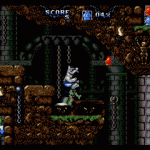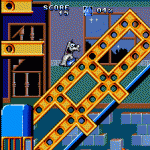Genre: Platformer Developer: Graftgold Publisher: Sega Europe Players: 1 Released: 1993
It’s time we had a look at another European exclusive release, one among the rare occasions when a Mega Drive game was produced solely for the European market, never to be brought to the U.S. or even Japan. And what better occasion than to have a closer look on a relatively obscure little platform game, based on a short-lived German cartoon series that in itself was based on a concept by a comedian that’s hardly known outside of Germany?
How this game ever came to be is a mystery in itself, though its conception sure must have been interesting. Ottifants are the invention of Otto Waalkes, a German actor and comedian who has been active since the 1970s (and who’s famous for low-brow jokes like: “What’s invisible and smells like rabbit? A bunny fart!”). Mostly, he is known for very silly, off-key humor in song, speech and mannerism, which is why he was often dubbed as “Der Blödelbarde” (“The Daffy Bard”) His career already spans over four decades, with several TV shows, audio plays and nine cinematic movies. Even though he’s well in his sixties, he’s still present in German cinema, with his latest film (“Otto’s Eleven”) seeing release in 2010. After hitting a slump during the 1980s his career revived in the early ’90s with his fourth movie, a TV series, and a short-lived cartoon based on his mascot, the so-called “Ottifant” (A simple drawing of an elephant with short, stumpy legs, a huge teethy mouth without tusks, and saucer eyes).
Even though his cartoon series didn’t last long and wasn’t too popular, it gained a lot of attention (mainly because it was the only animated TV series produced in Germany at the time). So Sega, apparently attempting to make a bigger break in the German market, acquired the license to turn the series into a video game for Game Gear, Master System and the Mega Drive. Development was handed to Graftgold, a company well known to 8-bit and 16-bit home computer users as the creator of classics like Paradroid or Uridium. Its greatest work would be for home computers, though, and apart from the occasional 8-bit console port, Ottifants would be its only Mega Drive Game. And what did it make of it? What most developers tried to do in that era: A mascot-based platformer!
So, a classic comedian only known in his home country, and a classic computer game developer only known for its 8-bit titles, joining forces well after their prime to create their only venture into the 16-bit home consoles? This did raise quite a lot of eyebrows, and even in Germany most magazines didn’t know what to make of it: The resulting game garnered both praising and scathing reviews, with some calling it “cute and fascinating” and others “mediocre and irritating.”
You control Bruno, a baby Ottifant with a blooming imagination. When his dad (Papa Bommel) goes missing after what seems to be a kidnapping by aliens, Baby Bruno sets out to the rescue. Even though he’s small, he isn’t defenseless. Enemies can be dispatched in the classic “bump on their heads with your butt” jump-’n-run style or by shooting jellybeans from your trunk. The adventure draws itself out over six cartoonishly colorful levels, each with three stages and a boss, and in such settings like “the house,” “the gardens,” a construction site and so on.
Those who’ve played Virgin’s Global Gladiators will feel an odd familiarity. Bruno behaves pretty much like Mick and Mack do in that game. He accelerates very slowly at first but gets faster as he gains more momentum. When shooting, his jellybeans move in an arc which can slightly be adjusted by pressing up or down on the D-Pad as well, and tapping the button produces several shots in short order. Even the sound effects are quite similar to the one year elder game by Virgin. The only difference is that there’s no kickback while firing, thankfully. What’s different is that when you hold down the B-button, instead of shooting Bruno uses his trunk to suck in air and pull certain small items (like bulding blocks for example) toward him and carry them around.
Even the level layout and the goals are kind of familiar. Instead of simply moving from left to right, Bruno has to explore the levels. Before reaching the end of a stage, the player has to collect a certain amount of gummi bears. Only once a certain percentage has been found can the level exit be entered. (Sound familiar? Well, apparently Graftgold was developing games for Virgin, the creator of GG, inbetween 1991 and 1993, so maybe it took some “inspiration” from there).
All similarity aside, the game looks very nice in itself. The graphics are crisp and very colorful, and have a nice amount of detail to them. The facial expressions Bruno makes in certain situations are very cute and nicely done. Everything has a very kid-friendly appearance to it, like huge bees with bubbly eyes and cartoonish grins for example – though there is the occasional graphical detail that, while well crafted, doesn’t quite fit in with the overall kid-friendly theme (like the chained-up, buried skeletons in the dungeon levels). With all the nice in-game graphics, it’s a shame that title and continue screen are very bland, nothing more than a pixilated cartoon drawing. The menus are just bouncing text over a black background. Surely the developers could have spent a little more time in improving the presentation! The music is decent, though very repetitive; you only hear one piece of background music per level, so it can get quite bland after playing the game for a while.
While the game itself sure looks and sounds pretty enough, the gameplay can be downright frustrating! As mentioned before, Bruno accelerates rather sluggishly. However he constantly carries enough momentum that it can be very hard to make him stop before running into an enemy, falling down a pit or running slowly but unavoidably into instant death spikes, which can suddenly appear out of nowhere, too! This also makes jumping a very awkward, imprecise and at times an outright risky affair. Attacking an enemy can thus become a challenge in itself. A pinpoint jump is almost impossible to pull off, and since the shots are fired in an arc they more often than not simply pass over your opponents without touching them. And whenever you need to use springs to reach a higher platform, the controls can become an extraordinarily grueling affair. The difficulty, though technically adjustable, is actually quite hard: The easier difficulties only limit the number of levels (on the lowest difficulty setting there are only three levels accessible), and the number of gummi bears needed to reach the next stage.
The level design is very irritating. Too often you find yourself making a leap of faith because it’s impossible to see whether there’s solid ground underneath or a deadly pit. The levels can become a confusing maze when it’s unclear in which the exit is found. Sometimes a hand points you in the general direction, but mostly you’re on your own. It doesn’t help that some switches that clear the right passage are found in hidden passages that can only be found by running into a wall and trying your luck. And speaking of switches: when you push a button, you have no indication of where something has happened or what it did . You have to backtrack and look around everywhere whether a passage has cleared. Luckily, there’s no time limit, so you can take your time clearing a stage, and given the design, it can take quite a while. However, aside for the old switch press or block puzzle, and the occasional hidden bonus stage where you collect gummi bears for bonus points under a time limit, there is hardly any diversion in the game, and so later stages can become very boring to trudge through. Finally, there are the boss fights. The bosses take a ridiculous amount of damage, while they kill you in only a few hits. Though there is a certain pattern to their attacks, your best chance in defeating them is finding their weak spot and then firing away as fast as you can, hoping that you can bring them down before they’re able to hit you.
While very nice to look at, Ottifants is nothing to write home about: The controls are sluggish, the level design is frustrating, and the gameplay becomes repetitive and boring after a while. The European Mega Drive scene didn’t see many exclusives, and so many magazines were probably a bit more lenient when reviewing the game, but overall this is only a mediocre effort at best, some above average graphics and nice sound combined with sub-par gameplay. While certainly not as bad as some other mascot-based platformers created in the 16-bit era, it’s sad that the developers didn’t put a little more effort into one of the scant few exclusive European releases.
SCORE: 6 out of 10










I agree with this review. It´s nothing spectacular, but not the awful mess many movie- and TV-tie ins end up being.
A funny sidenote:
Otto Waalkes himself was an active Mega Drive gamer. So active, that he even contributed cheats for some game to the readers´ tips & tricks section of a German Sega magazine once. 🙂
Not as a special editor, but with a plain letter to the mag as any other reader. 🙂